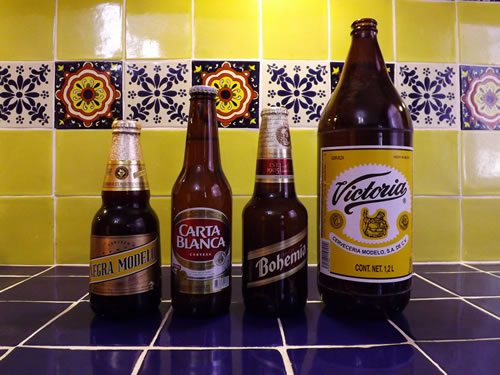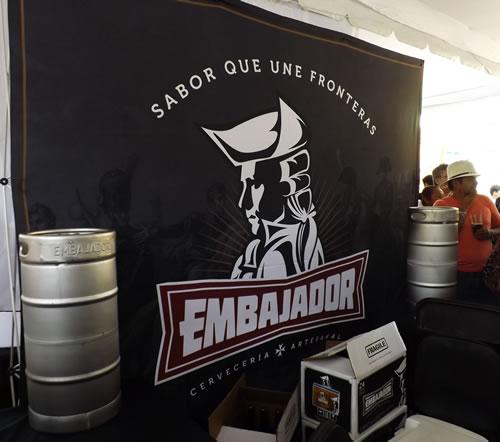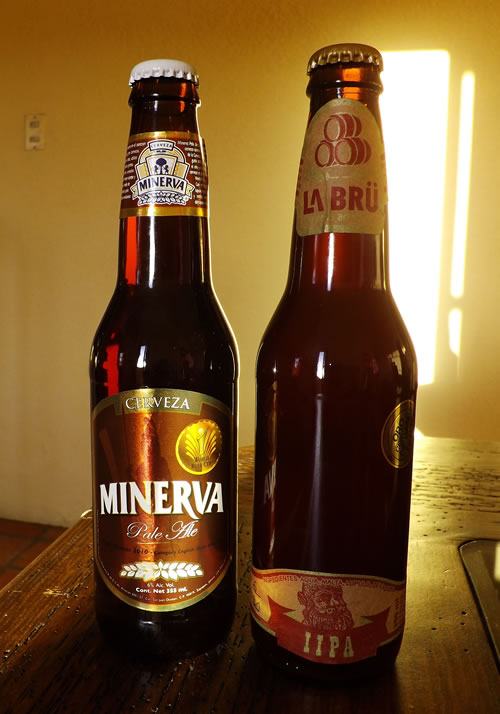|
The Guide to Cerveza in Mexico
Best and Worst Mexican Beer
Article and photos by Tim Leffel

|
|
Four sample bottles out of the wide variety of Mexican beers.
|
In most Latin American countries, beer is a letdown. One or two brands usually dominate the market and generally present minor variations on a similar taste profile.
Mexico is an exception to the rule, with a long history of quality beer at reasonable prices, with a wide array of choices. Early inhabitants of the region made a variety of fermented drinks from the agave cactus and corn, but Europeans introduced beer from the homeland as they arrived. Some Mexican brands have surprisingly long histories of a century or more, thanks to German and Swiss brewers that established companies in the 1800s. In a footnote of Mexican history, the Austrian emperor Maximilian ruled much of the country for a brief four years. Left behind were recipes for darker beers, the precursors to Negra Modelo, Bohemia Obscura, and Dos Equis Amber today.
The Microbrew scene has drastically improved since I wrote the first version of this article in 2009. Though rarely in a convenience store or supermarket, you can now find a staggering variety of pale ales, stouts, wheat beers, and more obscure offerings throughout the country. You must seek them out at bars and restaurants with taste or a specialty beer store. For now, you’ll have an easy time of this in the big cities, an impossible time of it in small towns. Guanajuato, a city of 300,000, hosted its first craft brew festival in mid-2014. I could taste offerings from Irupuato, Zacatecas, San Luis Potosi, Queretaro, and other cities besides my own. Things are looking up for those who want to go beyond the mass-market brands.

|
|
Embajador at the Guanajuato craft brew festival.
|
Otherwise, two powerful companies tightly control the beer market: Cuauhtémoc-Moctezuma Brewery and Grupo Modelo. Heineken owns the first, and InBev (who also holds Budweiser) owns the second.
Thankfully, the Mexican producers haven’t taken the easy way out and just produced a line of bland, indistinguishable beers. Even the average brands are better than the mass-market yellow fizzy water you get in the U.S. from the big boys, while the good ones are great.
Where to Buy Beer in Mexico
Beer is widely available in stores, bars, and restaurants in Mexico, with few of the silly restrictions you find north of the border. The drinking age is the age of adulthood: 18.
If you buy non-returnable bottles, you can be 99% sure they will end up in a landfill or on the side of a road. Cans have a slightly better chance of being recycled, especially in tourist areas, but Mexico is far behind the curve with reusing materials. The best bet is to buy returnables. Returnable bottles require a deposit, which you will get back when you return them to the same store — keep your receipt! Or you trade them in anywhere when buying new bottles and keep the chain going until it’s time to leave.
In bars and restaurants, you will find a “chelada” and “michelada” on the menu by the beer. The first is usually a beer glass rimmed with salt, filled with ice, and coming with a plate of cut lime or lime juice in the glass. A michelada is usually the same but with some kind of Bloody Mary hot sauce, Tajin dry pepper mix, and maybe some Worstershire sauce or Clamato. If you only see “chelada” on the menu, then it probably comes with hot sauce. Ask if that’s not your thing. You can usually pick which beer goes in it, but with all the salt and hot sauce taking over, it doesn’t much matter.
Expect to pay $1 or so for your average 12-ounce beer in a convenience store, and about $2-$3 in a bar or restaurant, depending on how fancy it is and whether it’s a tourist trap. In many cases, a beer will be about the same price as juice or bottled water, and in some places, you will get complimentary botanas snacks — all the more reason to order a beer!
Mexican Beer Brands
Here is a complete rundown of the major Mexican beers, from the darkest to the lightest. Just two companies manufacture all the national brands, so there are only minor distribution differences around the country.
Dark Beers — “Obscura” in Spanish
— Can be Outstanding
Bohemia Obscura — For real beer lovers who want to go beyond the typical offerings with something easy to find, Bohemia is the clear winner. German immigrants developed this tasty bock-style beer, and has tremendous depth compared to its peers on the shelf. It also has more alcohol, at 5.3%.
Any of the three Bohemia styles available in bars and restaurants will often be the most expensive beer, but only by a few pesos, so it’s worth the upgrade. Expect to pay a bit over a dollar in convenience stores, less by the bottle if you buy a six-pack. The main drawback of Bohemia is that it isn't available in returnable bottles, so drinking this is not helping Mexico’s mounting garbage problem.
Negra Modelo — The other true 5.3% alcohol premium beer, this fine malty brew is familiar to many Americans as it’s a staple in Mexican restaurants. It’s a sweetish, smoky dark beer that goes well with spicy and hearty Mexican food and is interesting on its own — no lime required. It’s the only dark beer you’ll frequently find on tap — including at the higher-end all-inclusive resorts.
Noche Buena — Only available around the Christmas holidays each year, this is a dark copper-colored bock-style beer at 5.3% alcohol that is more like a flavorful Shiner Bock than something from Bavaria. It’s a nice break from the norm, though and goes on sale in January for close-out prices in supermarkets.
Dark Lagers and Amber Beers
(All 4.5% alcohol unless otherwise indicated)
Dos XX Ambar — This “Vienna style lager” is another restaurant staple in the US. It has a more intense flavor than the norm and is a refreshing change from the sea of lighter beers, going well with hearty food. It has slightly more alcohol than most, at 4.7%.
Leon — Looks are deceiving with Leon, a beer that looks darker and maltier than it really is. It is like a wimpier version of Negra Modelo, but is widely available in large returnable bottles and is often one of the cheapest six-packs of cans in a supermarket.
Indio — This has long been the Pabst Blue Ribbon of Mexico, with the best packaging, design, and marketing (the brand sponsors many rock shows and DJ events). It used to be the cheapest beer by far, but it’s now on par with Tecate and Pacifico in price. The good news is that the flavor seems to this palette to have steadily improved over the years, probably due to better ingredients. It still has a lot of “off” flavors in its semi-dark depths, but at least it’s not bland — one of the easiest to find on draft — and better tasting on tap than in cans.
Victoria — This is a popular choice for those who want to drink a couple of beers while keeping a clear head, as it's only 4% alcohol. It’s surprisingly flavorful though, and is widely available in small and large returnable bottles.
Clear Lagers
in Mexico Impress
(All 4.5% alcohol unless otherwise indicated)
Bohemia Lager — is by far the best beer in Mexico you can see through. It’s an unabashedly European lager with far more complexity than the competition and 5.3% alcohol. One to sip and savor. There’s also a wheat beer version — for you Shock Top and Blue Moon fans.
Modelo — This sister beer to Negra Modelo is touted as a premium beer and comes with a neck wrapped in foil in bottles, but in reality, most people wouldn’t be able to distinguish it from most others in a taste test. It has a little more body and heavier finish than the Corona class though, and also comes in cans.
Dos XX Lager — The Rolling Rock of Mexico, in a green bottle with a strangely sweet taste. Available in cans as well.
Carta Blanca and Estrella — These similar-tasting brands used to be quite common but seem to be fading away into obscurity. Neither is a standout, but Carta Blanca is now the cheapest one on the shelf in a store. That would generally make it popular with those on a budget, but at just 4% alcohol, it’s not.
Corona — One of the five best-selling beers in the world, but it usually tastes better in Mexico, where the bottles don’t have so much time in transit and on shelves. (Sunlight coming through clear bottles is never good for beer.) Corona is the typical “drink all afternoon” beer, working well on its own or with a plate of tacos and refreshing with a lime.
Sol — While Corona wins the marketing wars in the U.S., Sol is the winning brand in much of Mexico, despite not being a standout in any respect. You see the logo plastered everywhere and it’s seemingly on every restaurant and bar menu. It’s simple and inoffensive, like Corona, but still slightly more flavorful than your typical American macrobrew. At its best ice cold, and progressively worse as it gets warmer.
Montejo — Named after the Spaniard who conquered the Yucatan and left a trail of blood in his wake. Less dramatic than its name would suggest, but a nice change of pace.
Superior — Very similar in taste to Montejo and available in big returnable bottles or cans.
Pacifico — A bit more bitter and hefty than Corona, Montejo, or Sol, many beer drinkers view this as the best of the light lagers, and it is especially popular in the western half of the country. Launched by three Germans in Mazatlan in 1900 and still brewed there.
Corona Especial — There’s nothing “especial” about this cheaper beer and it bears little resemblance to the regular Corona. Available in big quart bottles when quantity is more important than quality.
Tecate — Sold mostly in cans, this is a “load up the cooler” kind of beer that is nothing to get excited about. If you are staying at a low-end all-inclusive resort, this is what they will probably be serving.
Tecate Titanium — An old-school malt liquor like you find in 40-ounce bottles in the USA, but here “high alcohol” is relative. This one is at 5.5% and is basically regular Tecate with a bit more buzz for your buck.
Light Beers
in Mexico Disappoint
Tecate Light — Billed by a friend who lived in Mexico for a year as “the worst beer I have ever tasted,” this is one to avoid at all costs unless you are on a crash diet. It’s as bad as Coors Light, which is saying a lot. Has 3.9% alcohol.
Modelo Light — Almost as bad as Tecate Light, but not quite, with just 3.7% alcohol.
Corona Light — Another watered-down version of a well-known brand, but the only one that has more than 4% alcohol.
Craft Beers Are Now Flooding All Over Mexico

|
|
Two of the new breed of many fine Mexican craft beers.
|
It used to be nearly impossible to find microbrews in Mexico outside of Mexico City and Guadalajara, but now the laws have been relaxed, and there’s a flood of choices. You’ll pay twice as much or more for these beers, starting at the equivalent of $2-$3 per bottle in a store and $4-$5 and up in a bar or restaurant. The quality is surprisingly good this early in the game, however, and if you sample a flight of them in your favorite styles, you’ll find very few duds. Most are in the 5-6% alcohol range.
The best bet is to ask and look around wherever you’re headed in the country, but it's in big cities that there are specialty bars now serving a wide selection of craft beer. If you love porter, Indian pale ale, black lager, or Belgian white, chances are there’s a Mexican version.
Tim Leffel is the author of several books, including A Better Life for Half the Price: How to prosper on less money in the cheapest places to live. See more on his Cheapest Destinations Blog. He owns a home in Guanajuato, used to own a beach house near Merida, and has lived there on and off drinking and comparing beer for many years.
|
